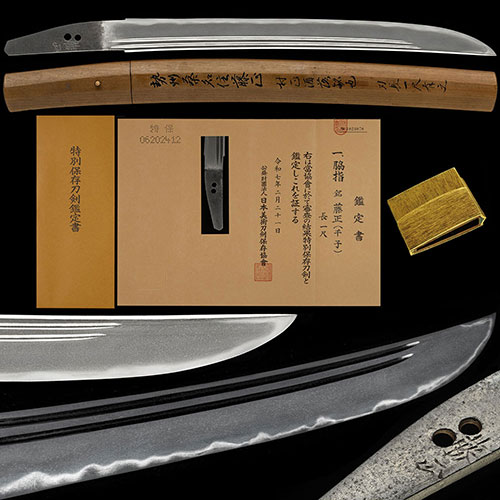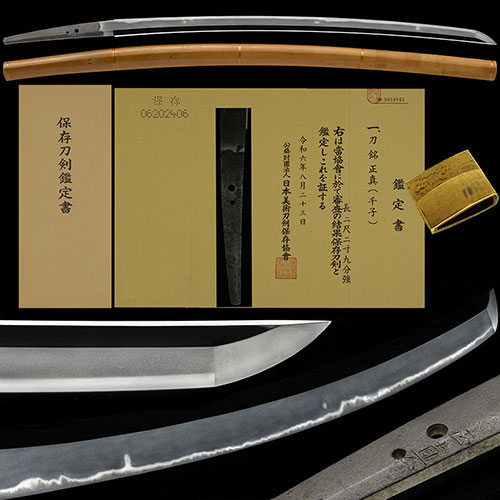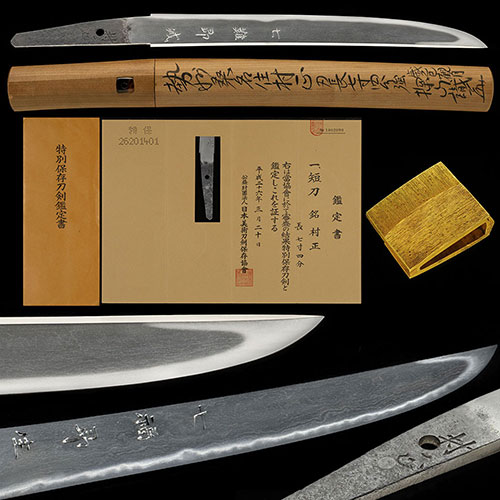
藤正 脇差Fujimasa Wakizashi
No.685023藤正 村正洒落銘 タナゴ腹茎 のたれに互の目交じり表裏揃う典型作 金筋砂流し掛り地刃明るく冴える優品 一尺Fujimasa Muramasa Syaremei, Tanagobara-Nakago, Notare, A classic work with a smear pattern on both sides, Notare and mixed Gunome, Kinsuji and Sunagashi-kakari, Jiba is bright and clear, an excellent sword 30.3cm
- 極めKiwame
- 藤正Fujimasa
- 登録証Registration
- 鳥取県 Tottori 昭和26年5月8日 5/8/26(Showa)
- 時代Period
- 室町後期天文頃Late Muromachi period, around Tenbun period
- 法量Size
-
刃長 30.3cm (1尺) 反り 0.3cm
元幅 2.7cm 元重 0.45cm 茎長 9.8cm 重量 156gHachou 30.3cm (1尺) Sori 0.3cm
Moto-Haba 2.7cm Moto-Kasane 0.45cm Nakago-Chou 9.8cm Weight 156g - 国Country
- 伊勢Ise
- 姿Shape
- 平造、庵棟、僅かに反りつく。Hiradukuri, Iorimune, slightly Soritsuku.
- 鍛Kitae
- 板目肌つみ、杢目肌交り、地沸微塵に厚くつき、地景よく入り、鉄明るく冴える。Itamehada-tsumi, Mixed Mokumehada, Jinie entered fine and techie, Chikei entered finely, Iron is bright and clear.
- 刃文Hamon
- 浅くのたれて、互の目交じり、足入り、小沸深くつき、金筋・砂流し掛り、匂口明るい。Shallow Notarete, Mixed Gunome, Ashi entered, Small-Nie entered deeply, Kinsuji and Sunagashi-kakari, Nioikuchi is bright.
- 帽子Boushi
- 地蔵風に小丸、深く返る。Jizo-style-Komaru, Deep return(Fukaku-kaeru)
- 茎Nakago
- 生ぶ、先入山形、鑢目勝手下り、目釘孔二。Ubu, Sakiiriyamagata, Yasurimekattesagari, Mekugiana are two(2)
- ハバキHabaki
- 金着二重。Double Kinkise
- 彫物Carving
- 表裏に二筋樋を彫る。Carve two lines of "Hi" on the front and back.
- 説明Drscription
- 村正が徳川家に祟る刀といわれた所以について、徳川将軍家の公式記録である「徳川実紀」によると、家康の祖父松平清康が天文四年(1535年)に家臣に村正の刀で斬られた事に始まり、父広忠が乱心した家臣に村正の脇指で刺され、信長から内通の嫌疑をかけられ、切腹に追い込まれた家康の長男信康を介錯した刀も村正であり、また、家康自身も信長の甥長孝の戦功報告を受けた際に、村正の槍を検分中に手に怪我を負ったりと、凶事がいくつも重なったとあり、村正は徳川家に祟る妖刀として一般に広く認知されるようになった。初代村正は、美濃赤坂兼村或いは関兼春の門で、美濃から伊勢国桑名の地に移住したと伝わり、初代村正の現存する最も古い年紀が文亀元年(1501年)で、以後代の継承がみられ、天文頃の村正が二代、天正頃の村正を三代としている。藤正銘は、村(むら)を紫にかけ、紫の花といえば藤と、村正が洒落で切った銘と言われている。現存数振りしか確認されていない希少なものである。この刀は、一尺ちょうどの大振りの短刀で、タナゴ腹茎に、杢目交じりのよくつんだ美しい地鉄に、のたれに互の目まじりの表裏が揃った刃を焼き、小沸深くつき、金筋・砂流し掛る典型作で、地刃明るく冴える優品である。Regarding the reason why Muramasa was said to be a sword cursed by the Tokugawa family, according to the official record of the Tokugawa shogun family, ``Tokugawa Jikki'', Ieyasu's grandfather, Kiyoyasu Matsudaira, killed his vassals with Muramasa's sword in 1535. Muramasa was also the sword that helped Ieyasu's eldest son Nobuyasu, who was forced to commit seppuku after his father Hirotada was stabbed by Muramasa's armpit finger by a mad vassal, and who was suspected of being an insider by Nobunaga.
In addition, when Ieyasu himself received a report of his military exploits from Nobunaga's nephew Nagataka, he injured his hand while inspecting Muramasa's spear, and it is said that he suffered a series of misfortunes, and Muramasa cursed the Tokugawa family. It became widely recognized as a witch sword.
The first Muramasa is said to have moved from Mino to Kuwana, Ise Province, at the gate of Mino Akasaka Kanemura or Seki Kaneharu.The oldest surviving Muramasa 1st generation is in 1501, and it has been handed down from generation to generation. The Fujimasa inscription is said to have been a pun by Muramasa, combining the word "mura" (village) with "purple" and referring to wisteria as a purple flower. It is a rare specimen with only a few known to exist. This sword is a large, tanto (short sword) measuring exactly 1 shaku. Tanagobara-Nakago, Mixed Mokume with tsunda beautiful Jigane, Notare, The blade has a uniform surface with a mixture of tare and Gunome. Small-Nie entered deeply. This is a typical example of superior piece, Kinsuji and Sunagashi-kakaru, Jiba is bright and clear, an excellent sword.




